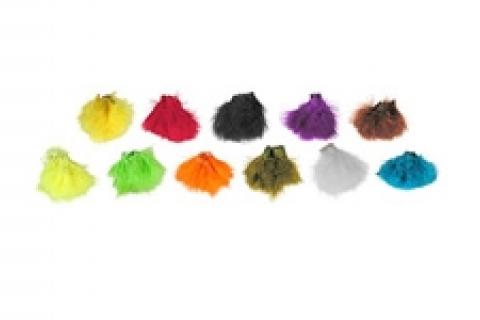
Of all the different feathers used by fly tiers, the marabou feather has to be one of the most unique and useful materials to ever grace a hook. Marabou can be used on fly fishing flies in many different ways, ranging from gnarly-looking bodies, fluffy wings, to undulating tails.
| Perhaps no other tying material has influenced the tying of big fish flies such as marabou, while still having endless uses in traditional patterns. |
The best thing about using marabou on flies is that tiers can be relatively inexperienced and still create life-like imitations, which is why tiers should become familiar with it early in their tying careers. Once a marabou fly enters the water, it instantly comes alive, and the breathing and dancing action attracts interest from even the most lackadaisical fish.
What to look for when choosing Marabou feathers
- Marabou feathers can vary greatly in size, ranging from 1 inch to 7 inches. For the beginner tier, feathers ranging from 3-4 inches are ideal because they can be used for a wider variety of patterns.
- Look for either strung or bundled bunches of feathers. Having the feathers attached at the quills will keep your work station much cleaner from loose feathers and allow you to save time and headaches when replacing the feathers back into their respective packages.
- Make sure feathers are fumigated, washed, rinsed, sorted and graded. These feathers might be a little more expensive then other marabou feathers but the feather in general will be much softer, flexible and easier to work with, making your flies look better and work smoother in the water.
Types of Marabou Feathers
Long and Fine: This special type of marabou has many different uses for the creative fly tier but most standard uses take place in the form of streamer wings. These feathers range anywhere from 3 to 7 inches in length and are very sparse in makeup with most of the tips aligning naturally. These long types of marabou make unique soft feather wings that when in the water create a slim, tapered profile for baitfish patterns. These wings also create a great amount of sultry fly action with little effort from the angler. Another good use of these long and fine fibers is for creating tails on streamer patterns. Since the tips on the fibers are relatively lined up it takes little effort to make nice squared-off looking tails for your flies. This kind of marabou works best for flashy full fly patterns like the Alaskabous, Marabou Speys and Marabou Tube Flies. This fine type of marabou can be wound around a tube or hook like a hackle. Most good plumes have a stem long enough for about 6-8 wraps on a hook or four wraps around a tube making a full-looking fluffy body.
Short and Fluffy: This special type of marabou feather is a little harder to come than the long and fine fibers seeing as the quality of these feathers needs to be high. These feathers generally range from 1 to 1 1/2 inches in length and are very dense with fine fibers. These short marabou feathers are ideally used in large nymph bodies or gills and can even be used as tails and wings on smaller streamer patterns. Tiers need to remember that if using these smaller clumps of marabou for tails and wings to be careful not to apply too thick of a bunch of feathers, ruining the balance of your fly. This kind of marabou works great for Leeches and Wooly Buggers (a standard of all fly boxes) or any application where the plumage doesn't need to be wrapped around a hook.
Tips for Tying with Marabou
- The number one rule when working with marabou is to wet your fingers. Dry marabou fibers can be impossible to handle even for the most experienced of anglers, a simple wetting of your fingers will mat down the small fluffy fibers allowing you to manipulate the fiber in any way imaginable.
- When tying in bundles of marabou for tails or wings keep the number of fibers used down to a minimum. Too big of a bunch of marabou and the fly becomes bulky and doesn't swim in the water right; too small of a bunch and the pattern loses its tapered profile.
- When creating bodies for baitfish patterns do not simply cut one thick bunch of marabou and tie it onto the hook shank, rather build the body bundling up one bunch of marabou in front of another. If the tips of the marabou are not quite even, the wing tapers, making it more effective as a baitfish imitation and much more streamlined in the water.
Perhaps no other tying material has influenced the tying of big fish flies such as marabou, while still having endless uses in traditional patterns. Marabou feathers, unlike almost all other types of feathers, have a very special quality that most tiers and anglers alike will agree on. When wrapped on a hook and submerged in flowing water, marabou has the ability to move and impart amazing life-like action while at the same time giving almost no drag to the fly. These two qualities make marabou a must have for the creative tier looking to score a few points with the fish with a few homemade flies.
- 9212 views


